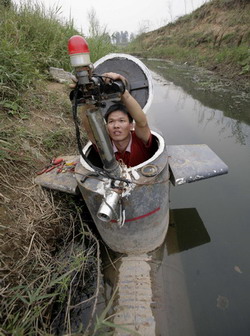-
News >China
In Shanghai, homage to China's peasant inventors
2010-06-03 09:59Hanging in an atrium are submarines built by Li Yuming while watching over his bedridden wife. Next door, in the huge lobby of what used to be the National Industrial Bank Building is a 65-foot-long "aircraft carrier", one commissioned by Cai to form a mini-cinema where he screens a documentary about the inventors.
The ship was built by Tao Xiangli, who left his rural home in east China's Anhui province to work in a karaoke lounge in Beijing, but put together a submarine from gasoline barrels, a manometry device to control ballast and other scrap materials.
"A helicopter is just a flying stool," Cai quotes another inventor, 68-year-old Wu Zhuzai, as saying of his not-so-airworthy wood and canvas contraption, built so that he could leave his village to "see the world."
Then there is robot enthusiast Wu Yulu, whose family has set up a workshop at the museum to tinker with their inventions while visitors watch. He somberly climbs into a rickshaw pulled by his walking and talking robot, whose ears flap and eyes shift wildly from side-to-side.
"Wu Yulu is my father. I'm taking him shopping," the robot intones.
"Most of the technical problems with my robots, I solved in the middle of the night in our courtyard while everyone else was sleeping. Most people would think I was a crazy person, walking about in the yard, but I was imitating the human movements," said Wu, who has won awards for his innovations.
Along with Wu's own robotic games, monkey robot, rat robots,and toddler-sized robots are several commissioned by Cai, including one meant to represent Jackson Pollock splashing paint.
The inventors, says Cai, are "smarter and more confident that I had thought. Each has a different goal for himself. Some want to contribute to the nation, some want to relive their childhoods."
"This puts them in a positive light instead of thinking they are ignorant or deserving of pity. It puts them in a place where they can receive our respect."
Running until July 25, the exhibition is the newly renovated Rockbund's first. The colonial-era building in Shanghai's Bund, whose huge waterfront banks and consulates are the city's most famous historic landmark, originally was occupied by the Royal Asiatic Society.

